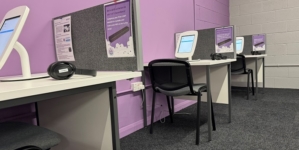-
BLACKOUT TECHNOLOGIES TARGETS TELEMATICS-INTEGRATED MOBILE DEVICE BLOCKING TO COMBAT SMARTPHONE DISTRACTION - April 1, 2025
-
OpenADR Alliance announces first OpenADR 3.0 certified products with EVoke Systems, E.ON Energy and Universal Devices - March 25, 2025
-
Growing fulfilment and contract packer appoints new Managing Director - March 25, 2025
-
When is it time to invest in a WMS? Understanding the key trigger points - March 25, 2025
-
eCapital helps Vantage Recruitment on its journey to financial success - March 24, 2025
-
Hugo Beck Celebrates 70 Years of Packaging Innovation with Open House Events - March 20, 2025
-
PROLOG FULFILMENT SUPPORTS LUNA DAILY’S COMMITMENT TO BETTER BODY CARE FOR ALL WOMEN - March 19, 2025
-
Motion Ventures launches largest-ever maritime tech fund at $100M to meet the industry’s new pace of adoption - March 18, 2025
-
ITD GLOBAL APPOINTS GROUP CHIEF REVENUE OFFICER - March 17, 2025
-
SURECAM TEAMS UP WITH ENTERPRISE FLEX-E-RENT FOR VEHICLE REPAIR & MAINTENANCE CONFERENCE - March 14, 2025
A new level of modularity.
While sorting automation has been key to improve operations, labour costs can still account for the majority of operating expenses, and often as much as 30% of space in every trailer is empty during transit.
As ever increasing parcel volumes have been creating a demand for both new last mile solutions and sorting automation, the potential savings within manual handling and transportation inside the terminal network has often been neglected. The existing infrastructure of roll cages, dollies or other equipment is often not up to the challenges presented by automation, combining letter and parcels streams or ergonomic handling.
To respond to these opportunities Posti Group and K.Hartwall started a project of building a new modular load carrier family in spring of 2017 that would take the efficiency of Posti’s parcel operations to the next level.
The decision to start developing and piloting the new concept was based on mutual vision that a modular load carrier family, where all load carriers are stackable and compatible with a standard 1200*1000mm footprint, would bring significant benefits to parcel distribution. The target was to use the Lean learnings from automotive sector to develop a wheeled unit which would be ergonomic and efficient to handle and at the same time could be double-stacked in transportation for optimal truck fill.
During concept design it became soon clear that even more benefits could be realised. The same platform could be integrated with existing cages and used for transporting other postal streams such as plastic letter totes on dollies and even standard wooden pallets. This would allow the same trucks to be used for different streams, minimizing transportation costs and maximizing fleet utilization. At the same time the new collapsible units would be up to 400% times more efficient in return logistics compared to the existing roll cages used today.
“Our intention is to develop load carriers which are easier and hence safer to use for our employees. Compatibility of the different load carriers brings great benefits as well, as improved truck fill by double stacking leads to lower transportation costs.”, says Peter Stavén, Head of Parcel Process at Posti.
In addition to benefits already identified, the best thing was yet to come: a small footprint load carrier would enable increasing the number of sorting destinations by allowing cross-docking in second terminal. This would bring huge benefits including reduced sorting costs, faster terminal throughput and later cut-off times.
“The new load carrier family where everything is both modular and stackable, combined with a smaller footprint, means that we can also use a bigger amount of pre-sorted units. This makes cross-docking possible and therefore reduces sorting costs significantly. “continues Peter Staven.
As current daily operations need to continue running smoothly, another important aspect is compatibility with the existing infrastructure including loading patterns, equipment and automation. For the project it was therefore essential that any new equipment was compatible with existing processes from day one, and that the roll out would be possible gradually. Therefore the first pilot has already created important user feedback and the concept has been developed along the way.
Today, as customers are demanding faster and more flexible delivery services, postal operators cannot afford to rely on outdated operational models but have to proactively look for future-proof solutions that can provide speed and flexibility at lowest possible cost.
Peter Standertskjöld-Nordenstam
Key Account Manager, Finland & Baltics

































